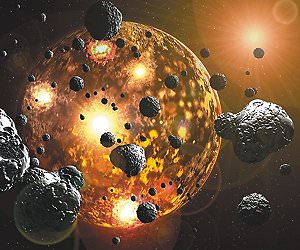 |
| Possible bacterial fossils in the Alan Hills Meteorite |
The team placed a 30,000 year limit on the computer model to take into account damage from radiation and cosmic rays. By applying the other constraints of velocity, trajectory, gravity and so on, the team found that just 5% would fall back to Earth. When it came to debris which actually would land on planets, 0.02% reached the moon, 0.17 reached Venus, 0.01 reached Mars, 0.06 reached Jupiter and just 0.19 fell into the sun. Interestingly, a staggering 6.75 reached the orbit of Pluto.
While these numbers are not physically big, in astronomical terms, they are still massive. The model showed that material ejected from the orbital side of a moving body rather than the trailing side could travel far further into space. One of the team's consultants, planetary scientist Dr Simon O'Tool from the Australian Astronomical Observatory, stated 'in the past we did not have the processing capacity to carry out these simulations beyond the Moon or Venus. Now thanks to more powerful computers, we can produce more detailed models which include the rest of the Solar System.
 |
| An artist's impression of the Late Heavy Bombardment |
The only uncertainty in this model is how long bacteria or bacterial spores can survive on a rock, hurtling through the boiling hot, freezing cold and radioactive wastes of deep space. A second consultant, Dr Charley Lineweaver from the Australian National University Mount Stromolo Observatory stated 'we don't even know how long bacterial spores can remain viable under ice. Bacterial survival in space is an active field of research, but the simple answer is we don't know how long bacteria could survive given the harsh space environment.'
Lineweaver went on to say 'it depends where the bacteria is. If it's on the surface, it's got less chance of survival than if it's protected by one, two or three centimetres of rock.' From 4.2 to 3.8 billion years ago, the inner Solar System was subjected to a vast asteroid bombardment called the Late Heavy Bombardment. Trillions of meteorites left over from the formation of the Solar System hurtled towards the sun, striking Mars, Venus, Earth, the Moon and Mercury. We can still see the traces of that violent time in Earth history today.
Who knows what mysteries were contained within the rocks. Metals, mineral, molecules or even microbes could have been brought to Earth by the billions of rocks that struck the Earth. We believe that life may have originated around 3.7 billion years ago, just after the Late Heavy Bombardment ended. This has been a long standing theory in the subject of the origins of life. Yet there has not been the numbers to back up this theory until this study.